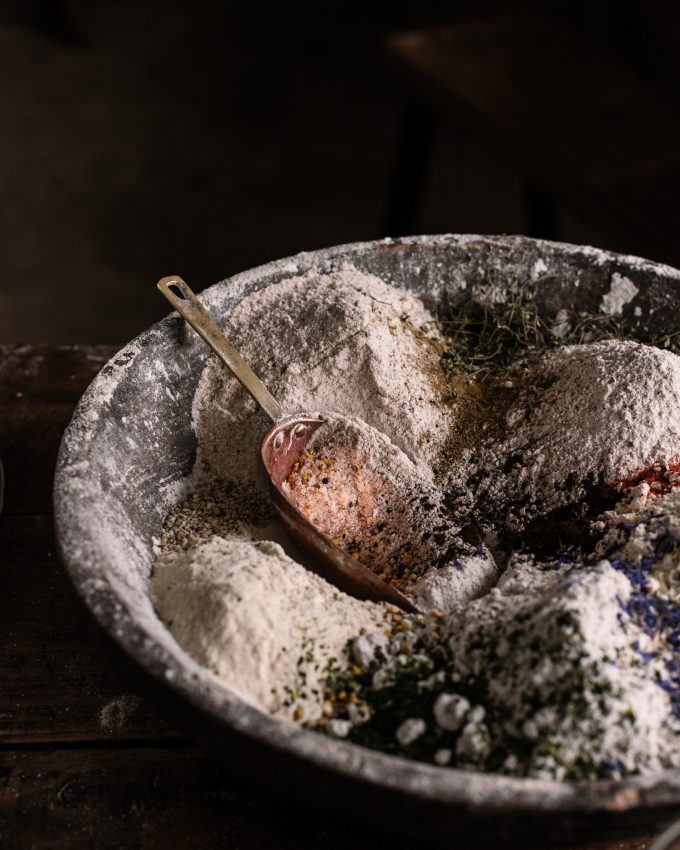 Most bakers are free thinkers. Often challenging the systems we live in. But the current definition of flour means that almost all bakers around the world all bake, create and develop their recipes with flour. That is wheat flour – which makes up 95% of all grain grown. So right now almost all bakers bake according to an industrial agricultural system of monoculture because the way in which grain is grown and milled for the past 120 years is for a system that has reduced our flour to a single ingredient to make industrialised bread.
Most bakers are free thinkers. Often challenging the systems we live in. But the current definition of flour means that almost all bakers around the world all bake, create and develop their recipes with flour. That is wheat flour – which makes up 95% of all grain grown. So right now almost all bakers bake according to an industrial agricultural system of monoculture because the way in which grain is grown and milled for the past 120 years is for a system that has reduced our flour to a single ingredient to make industrialised bread.
Think about it – even heritage bags of flour are monoculture – one grain, such as Rye, or Spelt, Einkorn, Emmer, or Khorasan.
My work, as a baker is centred completely on wellness. On making bread that nourishes the gut microbiome and monoculture is the antithesis of what we know the gut microbiome flourishes on. The gut needs diversity to thrive.
So I redefined wholegrain…
My botanical blends were inspired not from being focused on flavour, or texture but from a deep knowledge of how we should be baking our bread to be well. This approach almost came to me in the most beautiful moment I return to in my mind over and over again in an Italian valley. It was a feeling of completeness, of understanding that our wellbeing is linked in a perfect reflection of symbiosis. It was standing in this meadow, feeling sun ripening the crop and the breeze that I sensed everything. Fragrant oregano under my feet, wild oats, roses, and an olive grove and realised that this is what the harvest should be – the whole meadow.
For a moment I felt as though my heart broke as I fully understood that we had as bakers, as we intensified our food production system, all lost what we never knew we had – diversity. Fermentation alone is not enough to make bread that nourishes because we evolved eating both diversely and symbiotically with fermentation in a microbial world. We need to redefine the meaning of wholegrain flour.
Asking that you redefine wholegrain.
Understanding is one thing, but in communicating this I’ve never been more conscious of the fact that the principles I teach should be available to everyone and most bakers do not have a mill, but you don’t actually have to have a mill to mix a botanical blend. Milling creates the most exquisite flavours and opens up your flour to a whole range of diverse ingredients and nutrients.
So whilst my blends are based on using a home mill and blending fresh ingredients gathered, you can still mix and blend without a mill.
The blend is an example and it is just as effective in increasing diversity – it just means you might be a little more limited in the ingredients you can use to put your blends together.
Botanical Blend no 2 – no mill – Diversity score 10
An example of 1kg of Botanical Blend No 2 for 100% wholegrain diversity flour, you need a mix:
- 500g Strong organic wholemeal flour
- 200g Spelt flour
- 100g Einkorn
- 100g Emmer
- 50g Rye flour
- 20g Oats
- 15g ground flaxseed
- 5g dried finely cut herbs such as oregano
- 5g dried edible flowers such as rose petals or lavender – very finely cut
- 5g green tea very finely chopped
If you have a blender or a coffee mill you can process the herbs/spices/flowers then add them to the mix.
There are many ingredients that can be bought pre-milled and pre-ground and used in your botanical blends. For example, you can make a mix of base flours – maybe einkorn, emmer, spelt and rye flour, and that gives you a diversity score of four at the very beginning. You can then add two or three tablespoons of ground flax seeds, some dried herbs and spices, you could add some dried grated citrus zest. Dried rose petals and dried lavender can easily be bought online and finely chopped or crumbled into the mixture. And once the flowers begin to bloom outside, you can collect edible flowers, and dry them, to add to your blends. Homegrown herbs are another fantastic way to add diversity. Even a tablespoon of tea or coffee added to the flour will increase the diversity score.
While I create my botanical blends based on a meadow, you can base your blend on your pantry or your garden. It’s really about understanding the principle. Common bread wheat (Triticum aestivum) alone has a diversity score of one. I think most of us could increase the diversity score to 10 quite easily just by blending everyday ingredients that you can find in the store cupboard.
How to incorporate this flour into your bread
In general, my principle for blending these mixtures into the boules is roughly 80:20. For example, in the Meadow blend (Blend Number 2) I use 80% grain and 20% extra ingredients. And, of course, once these botanical blends have been made, they can be further blended with a strong white (13% protein) flour. You’ll often find me using anything between 20% and 50% of a botanical blend mixed with a stronger wheat flour to maintain the structural integrity and dough rheology that I love in a classic boule, while still getting the nutritional benefit from significantly increasing the diversity score.
Buy a Mill
I cannot overstate the joy and versatility of using a mill. The fresh flour really has the most incredible flavour and it’s certainly more nutritious because the ingredients don’t have time to oxidise. And to be honest – it’s fun, it really is. There’s something incredibly joyous about milling your own flour and adding in herbs, flower petals and seeds. As an added bonus, the flavours are exceptional. But remember that even without a mill you can still use the same principles for creating your own botanical blends. And you can, of course, always get your jam jar, label and felt tip pens out and get saving – I promise you it’s worth it!
Save.
When I first bought a mill I had to save for it. It took me a year. It now lives in a bakery in Paris and, I catch glimpses of it working on Instagram as it is still used every day. As a little girl when I really wanted to buy something, my mum would tell me to get a jam jar out of the cupboard. Then I would carefully write what I wanted to save up for on the front of a label, and tape this beautifully decorated label onto the jam jar. Week by week, month by month, I would put my pennies into the jam jar until it was full. And, after months and months, at last, my mum would take me to the shop so that I could buy the item I had so carefully written on that label. In a world when we are used to getting everything instantly I still feel that there is real joy in watching the jam jar fill up. It was just a few pennies or a few pounds at a time, but I always got to my goal in the end.
Sometimes, like learning to make sourdough, part of truly enjoying and valuing something actually comes through working towards it.
Vanessa x
